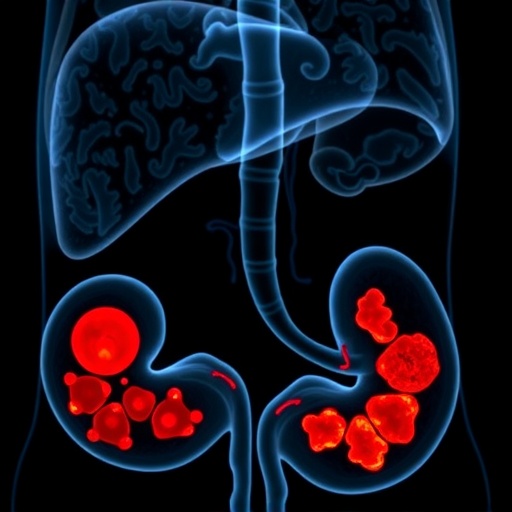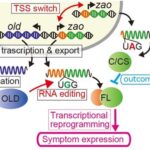
Intrahepatic cholangiocarcinoma (iCCA), a malignant tumor originating from the bile ducts within the liver, remains one of the most challenging hepatic cancers to treat, especially when multiple lesions are present. Recent research has delved deeply into the prognostic implications of tumor multiplicity in iCCA, aiming to better delineate which patients might benefit most from aggressive surgical approaches. A groundbreaking study published in the 2025 edition of BMC Cancer now offers fresh insights into the survival outcomes of patients with multifocal iCCA after radical resection, emphasizing the pivotal role that the number of hepatic lesions plays in prognosis.
Hepatic malignancies often present unique hurdles due to the liver’s complex vascular and biliary architecture. In iCCA, the presence of multiple lesions within one hepatic lobe adds layers of diagnostic and therapeutic complexity. While solitary tumors have traditionally been the primary candidates for curative surgical intervention, the treatment paradigm for multifocal tumors is far less defined. This new investigation categorized multifocal tumors based on lesion count and localization, stratifying them into three types: solitary tumors (Type I), two or three lesions confined to the same hepatic lobe (Type II), and cases with more than three lesions in the same lobe (Type III).
The researchers conducted a comprehensive retrospective analysis of 354 consecutive patients diagnosed with iCCA who underwent radical surgical resection. By incorporating stabilized inverse probability treatment weighting (IPTW), a statistical method used to reduce confounding factors in observational studies, they achieved an unbiased comparison of survival outcomes across the different lesion-number groups. This methodological rigor strengthens the study’s reliability and offers compelling evidence guiding surgical decisions in multifocal iCCA.
One of the striking findings was the stark contrast in overall survival (OS) and recurrence-free survival (RFS) between solitary and multifocal tumors. Patients with multifocal iCCA had significantly worse survival outcomes compared to those with solitary tumors, underscoring the aggressive nature of multifocal disease. However, within the multifocal cohort, survival varied considerably depending on lesion number. Those with two or three lesions exhibited survival rates comparable to solitary tumors after adjustment for baseline differences, whereas patients with more than three tumors experienced markedly worse prognoses.
Delving into the pathological dynamics influencing these outcomes reveals the biological aggressiveness associated with higher tumor burden. Multivariable Cox proportional hazards modeling confirmed that having more than three hepatic lesions is an independent risk factor for decreased overall survival, nearly doubling the hazard ratio compared to solitary tumors. This quantification highlights the intrinsic relationship between tumor multiplicity and tumor biology, possibly reflecting greater intraparenchymal spread, increased metastatic potential, or resistance to therapeutic interventions.
The study also situated its findings within the widely used American Joint Committee on Cancer (AJCC) staging framework, focusing particularly on stage II (T2N0M0) patients characterized by vascular invasion. It emerged that in this subgroup, multifocal tumors of type III had significantly worse overall survival than solitary tumors, while type II multifocal tumors showed survival rates akin to solitary lesions. This nuance indicates that not all multifocal iCCA cases should be treated homogeneously; instead, the number of lesions might refine the staging impact and subsequently influence treatment strategies.
Moreover, when comparing stage II and stage III patients, a paradoxical pattern emerged. Type II multifocal tumors demonstrated better survival than stage III patients, whereas type III tumors had similar survival, suggesting that lesion count could potentially supersede traditional staging in predicting outcomes. This could redefine risk stratification approaches and pave the way for more personalized surgical planning.
The implications of these findings resonate profoundly in the clinical decision-making process. Radical surgery, currently advocated as the cornerstone treatment for solitary iCCA, may also be justifiable and beneficial for patients classified as type II multifocal tumors. This challenges previous reticence around aggressive surgery in multifocal settings and advocates for a more nuanced patient selection, balancing the extent of surgical intervention with anticipated survival benefits.
Conversely, the dismal prognosis observed in patients with more than three hepatic lesions underscores the necessity of adjunct or alternative therapeutic modalities. For this subset, multimodal approaches including systemic chemotherapy, locoregional therapies, or inclusion in clinical trials might be warranted to improve outcomes. The study thus not only informs surgical candidacy but also signals an urgent unmet clinical need in managing extensive multifocal disease.
Beyond immediate clinical implications, this research invites further exploration into the molecular and genetic underpinnings differentiating multifocal iCCA subtypes. An improved understanding of the tumor microenvironment, genetic mutations contributing to multifocality, and mechanisms driving aggressive phenotypes could catalyze the development of targeted therapies, complementing surgical treatment.
From an epidemiological perspective, the study’s large, well-characterized cohort provides robust data for future meta-analyses and baseline comparisons. By standardizing the classification of multifocal tumors according to lesion number and location, it facilitates cross-study comparability and optimizes collaborative research efforts.
Furthermore, employing IPTW propensity-score analysis sets a methodological precedent in hepatobiliary oncology. This approach mitigates selection biases inherent in retrospective studies, thereby enhancing the validity of survival comparisons and offering a replicable model for similar investigations in complex oncologic scenarios.
In summary, this pioneering work decisively establishes that the number of hepatic lesions in multifocal intrahepatic cholangiocarcinoma is a critical prognostic determinant following radical resection. While multifocal iCCA overall portends a poorer prognosis compared to solitary tumors, patients bearing two or three lesions in the same hepatic lobe appear to obtain comparable oncological benefits from surgery. These insights advocate for the inclusion of lesion count in staging systems and treatment algorithms, promoting more personalized and effective management strategies.
This research uncovers a transformative avenue in the surgical oncology of iCCA, challenging entrenched perceptions and potentially expanding surgical indications. By reconciling tumor burden with survival outcomes, it equips clinicians with data-driven frameworks essential for optimizing patient-centric care in a notoriously lethal malignancy.
As the liver oncology field advances, integrating these findings with emerging systemic therapies and precision medicine approaches will be crucial. Ultimately, refining prognostic models based on lesion count and biological characteristics holds promise for enhancing survival and quality of life in patients afflicted with multifocal intrahepatic cholangiocarcinoma.
Subject of Research: Prognostic impact of hepatic lesion number in multifocal intrahepatic cholangiocarcinoma after radical surgery.
Article Title: Prognostic significance of the number of hepatic lesions in multifocal intrahepatic cholangiocarcinoma after radical resection: an IPTW propensity-score analysis.
Article References:
Zhang, X., Huang, XT., Xie, JZ. et al. Prognostic significance of the number of hepatic lesions in multifocal intrahepatic cholangiocarcinoma after radical resection: an IPTW propensity-score analysis. BMC Cancer 25, 930 (2025). https://doi.org/10.1186/s12885-025-13737-5
Image Credits: Scienmag.com
DOI: https://doi.org/10.1186/s12885-025-13737-5
Tags: bile duct cancer research insightscholangiocarcinoma survival ratesHepatic lesion counthepatic malignancies diagnostic challengesintrahepatic cholangiocarcinoma prognosislesion categorization in cholangiocarcinomaliver cancer treatment paradigmsmultifocal iCCA treatment outcomesprognostic factors in liver tumorsradical resection in liver cancersurgical strategies for iCCAtumor multiplicity in liver tumors



